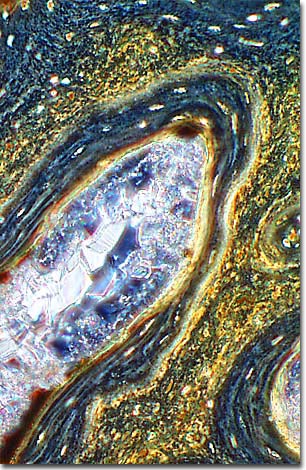Phase Contrast Image Gallery
Mosasaurus Vertebrae
Mineral formation within the Haversian canals is quite evident in this photomicrograph, which was taken during examination of a thin section prepared from mosasaurus fossilized bone fragments.

During the Cretaceous era, 145 to 65 million years ago, these large, carnivorous, marine reptiles dominated the oceans of the world, hunting for ammonites, fish, and cuttlefish. Once land-dwelling animals, they began to return to the sea in the early Cretaceous. Over the eons, they spent increasing amounts of time in the ocean and eventually their legs and feet evolved into flippers as they evolved into full-time marine animals.
Like today's whales and dolphins, mosasaurs had to come to the surface to breathe. Their young did not hatch from eggs, but were born live and may even have been cared for by their parents. Some fossil evidence indicates that these reptiles may have lived in social groups with an assortment of different ages and sizes.
To propel themselves through the water, mosasaurs swam with an undulating, side-to-side movement of their tails, like alligators. Whales and dolphins move their tails up and down to swim. Today, the closest living relatives of mosasaurs are monitor lizards, such as the Komodo Dragon, and possibly snakes.
BACK TO THE PHASE CONTRAST GALLERY
